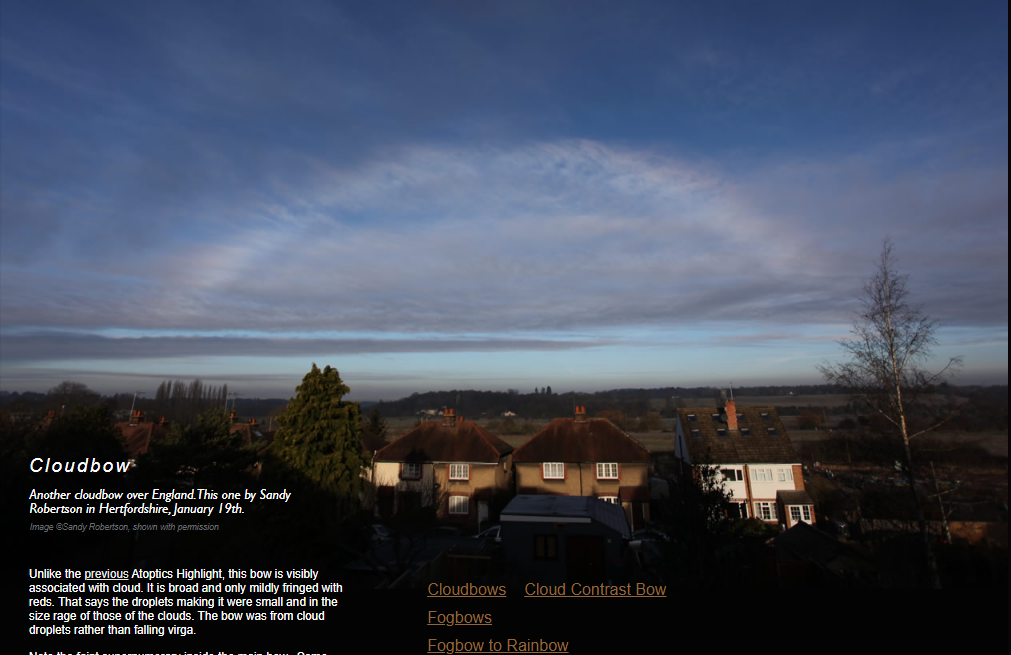Cloudbow
Cloudbow: A Phenomenon of Atmospheric Optics
When it comes to atmospheric optics, there are several captivating phenomena that can occur in the sky. One such phenomenon is the cloudbow. Similar to a rainbow, a cloudbow is a beautiful arc of colors that forms in the sky. However, unlike a rainbow, a cloudbow is associated with clouds rather than rain. In this article, we will delve into the intricacies of cloudbows and explore their formation and characteristics.
The Formation of Cloudbows
Cloudbows are formed when sunlight interacts with water droplets present in the clouds. These droplets act as tiny prisms, causing the sunlight to undergo refraction and dispersion. As a result, the white sunlight is separated into its component colors, creating the vibrant arc of a cloudbow. The formation of cloudbows is similar to that of rainbows, but instead of raindrops, it is the cloud droplets that play a crucial role.
Characteristics of Cloudbows
Cloudbows can exhibit different characteristics depending on the size and composition of the cloud droplets. Generally, cloudbows are broader and less distinct compared to rainbows. This is because the cloud droplets are smaller in size, which leads to less refraction and dispersion of light. Consequently, cloudbows may appear slightly fringed with colors, but the intensity is usually milder than that of rainbows.
Cloud Contrast Bow
One interesting type of cloudbow is known as the cloud contrast bow. Unlike other cloudbows, this particular bow is visibly associated with clouds. It appears broad and may exhibit mild fringing with reds. This indicates that the droplets responsible for its formation are small and similar in size to those found within the clouds themselves. It is important to note that the cloudbow originates from cloud droplets rather than falling virga, which are streaks of precipitation that evaporate before reaching the ground.
Supernumerary Inside the Main Bow
Observing a cloudbow closely, one may notice a faint supernumerary inside the main bow. Supernumerary bows are additional, less distinct arcs of colors that sometimes appear alongside rainbows or cloudbows. They occur due to interference between light waves as they pass through the droplets. The presence of a supernumerary within a cloudbow adds an extra touch of complexity and beauty to this atmospheric phenomenon.
Studying Cloudbows with IRIS Simulations
In order to gain a deeper understanding of cloudbows and their characteristics, researchers have turned to simulations using tools like IRIS (Interference Rainbow Simulation). These simulations allow scientists to explore the actual droplet diameter involved in cloudbow formation. By analyzing the data obtained from these simulations, researchers can further refine their knowledge about the intricate details of cloudbows and gain insights into the behavior of cloud droplets.
Conclusion
Cloudbows are captivating atmospheric optical phenomena that add a touch of wonder to the sky. Formed through the interaction of sunlight with cloud droplets, these arcs of colors offer a unique spectacle for observers. While cloudbows may not be as distinct or intense as rainbows, they possess their own charm and beauty. Whether it's admiring the broad cloud contrast bow or marveling at the faint supernumerary within the main bow, cloudbows continue to intrigue and fascinate those who take the time to gaze up at the sky. Through ongoing research and simulations, scientists strive to uncover more about the intricacies of cloudbow formation, enhancing our understanding of this mesmerizing atmospheric phenomenon.

Cloudbow
Another cloudbow over England. This one by Sandy Robertson in Hertfordshire, January 19th.
Image ©Sandy Robertson, shown with permission
Cloudbows Cloud Contrast Bow
Unlike the previous Atoptics Highlight, this bow is visibly associated with cloud. It is broad and only mildly fringed with reds. That says the droplets making it were small and in the size rage of those of the clouds. The bow was from cloud droplets rather than falling virga.
Note the faint supernumerary inside the main bow.. Some simulations with IRIS would reveal the actual droplet diameter.
Note: this article has been automatically converted from the old site and may not appear as intended. You can find the original article here.
Reference Atmospheric Optics
If you use any of the definitions, information, or data presented on Atmospheric Optics, please copy the link or reference below to properly credit us as the reference source. Thank you!
-
<a href="https://atoptics.co.uk/blog/cloudbow-3/">Cloudbow </a>
-
"Cloudbow ". Atmospheric Optics. Accessed on November 25, 2024. https://atoptics.co.uk/blog/cloudbow-3/.
-
"Cloudbow ". Atmospheric Optics, https://atoptics.co.uk/blog/cloudbow-3/. Accessed 25 November, 2024
-
Cloudbow . Atmospheric Optics. Retrieved from https://atoptics.co.uk/blog/cloudbow-3/.